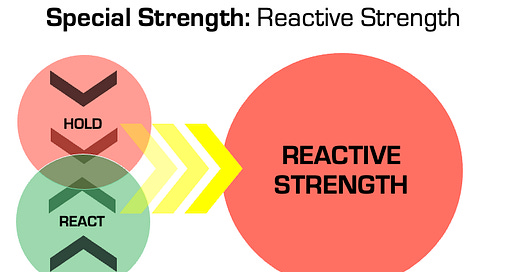Special Strengths: The Difference Between Reversal Strength & Reactive Strength
A new realm: the special strength of reversal strength.

Neurological-Biological Synergizing Force Output→ ”Special Strengths”
Both reactive strength and reversal strength are what Soviet sports scientists—the ones who first violently broke ground in establishing the foundation of modern strength training for sport—would term "special strengths."
For the modern-day strength practitioner—especially one working within the reactive strength paradigm—it’s paramount to recognize that these two represent distinct nervous system behaviors and, therefore, different force outputs (i.e., strength) when viewed from the inside out. By understanding what makes each strength "special"—or, more accurately, what makes them unique—we can avoid conflating the two in training.
Recognizing these distinctions is critical for adhering to the Biological Law of Specificity1 in both training and clinical work. This allows us to properly execute thermodynamic biological cycles of propagating2 work that stimulate and/or maintain the appropriate subelements of each special strength.
Avoid Conflating Reactive Strength With Reversal Strength
If we conflate the two and we get this wrong with our work—and trust us, it’s easy to think you are training reactive strength when in reality you are training reversal strength—our work could end up scaling up the neurology to the point where there’s a mismatch between what the nervous system can output and what the biological tissues can handle during dynamic force transmission scenarios at the level of competition.
We call this neurological-biological asymmetry, or, more dramatically, standing on the tracks as the reactive strength train barrels toward your athlete’s connective tissues—because if you can’t get them to move off of the tracks, we all know what happens: reactive strength injury.
Defined: Reactive Strength & Why It Matters
The devil is in the details, so let’s dissect reactive strength to a deeper level for you.
Reactive Strength: The connective tissue’s ability to efficiently behave during the stretch-shortening cycle (SSC), relying on specific connective tissue behaviors such as controlled lengthening, elasticity, and other reactive behaviors that emerge in conjugation with primarily a top-down isometric muscle action.
This special strength is a fundamental element of Point B, as we are always performing specific work that positions the athlete’s connective tissue to have the capacity to absorb, store, and re-release force efficiently.
But let’s take it a step further. What happens when the athlete needs to violently change direction? Does that still fall under the umbrella of reactive strength, or are we stepping into a different realm entirely?
Reversal Strength: A New Realm
We are stepping into a new realm—welcome to the realm of reversal strength! In researching this special strength, we turned to Louie Simmons’ Special Strength Development for All Sports for guidance, only to find reversal strength isn't even listed.3 Interesting—perhaps we’ve found ourselves at the edge of chaos—where new knowledge emerges that stimulates our understanding of strength to evolve…
Keep reading with a 7-day free trial
Subscribe to Absolute: The Art and Science of Human Performance to keep reading this post and get 7 days of free access to the full post archives.




